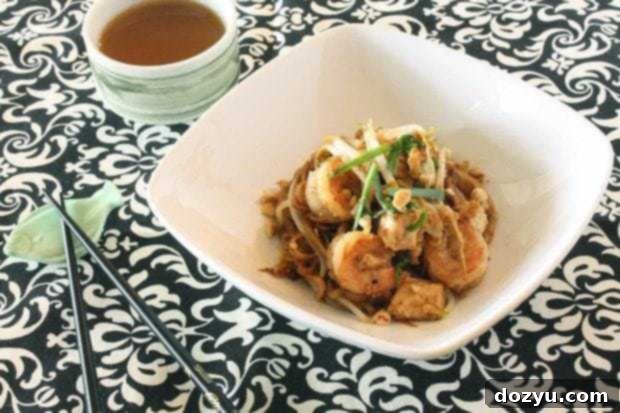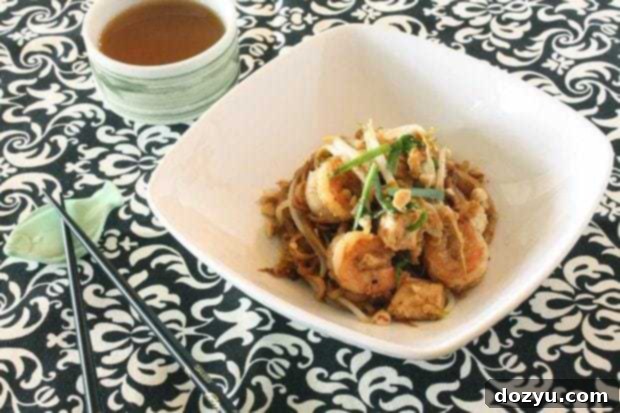Authentic Homemade Pad Thai Recipe: Master This Classic Thai Dish at Home
Embarking on the journey to master an authentic Pad Thai recipe at home was, admittedly, quite an adventure for me. This beloved Thai classic, renowned for its vibrant flavors and satisfying texture, took me more than a few attempts to truly get right. But, as with any worthwhile culinary pursuit, the persistence paid off, and now I’m thrilled to share a recipe that truly captures the essence of this incredible dish.
My initial foray into the world of Pad Thai was largely inspired by my husband, a man who, without exaggeration, considers this dish his favorite food on Earth. Despite his unwavering devotion, I was surprisingly unfamiliar with its nuances. So, before I even thought about tackling it in my kitchen, I decided to conduct some vital research. This led us to a fantastic Thai restaurant in Denver, famous for its Pad Thai. The experience served as my benchmark – a culinary compass guiding me toward what an truly exceptional Pad Thai should taste like. If my discerning husband approved of *their* version, it was a solid foundation upon which to build my own Pad Thai aspirations.
Truth be told, achieving a truly great homemade Pad Thai does require a bit of practice and patience. My first attempt, fuelled by enthusiasm but lacking in experience, was, to put it mildly, a bit of a disaster. The noodles turned out remarkably chewy, a testament to my then-limited understanding of rice noodle preparation. However, these early missteps were invaluable learning experiences. By the second try, armed with more familiarity with the ingredients and a clearer memory of the cooking process, I was better organized, and the results were significantly smoother and far more delicious. This journey taught me that while it might seem daunting, Pad Thai is incredibly rewarding to master.
The Secrets to a Speedy & Successful Pad Thai
Here’s the honest truth about making Pad Thai: it becomes incredibly easy *once all your ingredients are prepped and ready*. This concept, often called “mise en place,” is paramount in fast-paced stir-fries like Pad Thai. The two primary hurdles that tripped me up during my initial attempts were mastering the tamarind purée and properly handling the rice noodles.
- Tamarind Purée: Preparing fresh tamarind pulp can be a bit messy. My first go-around involved trying to squeeze the pulp by hand, which yielded minimal results. I quickly learned the magic of a fine-mesh sieve, which effortlessly separates the rich, tangy pulp from the fibrous veins, membranes, and seeds. If you can find ready-made tamarind concentrate, it will save you time, but making it from a block offers a more authentic flavor and is more economical.
- Rice Noodles: Choosing the correct size of dried rice noodles (typically 2-3mm wide) and soaking them for just the right amount of time in room temperature water is crucial. My early mistake was using the wrong size and not soaking them long enough, leading to stubbornly hard noodles no amount of stir-frying could salvage. Properly rehydrated noodles will become pliable but still firm, ready to absorb the incredible flavors of the sauce without turning mushy or remaining chewy.
Once these key elements are under control, the actual cooking process is remarkably swift. You’ll find yourself stir-frying at high heat, with ingredients transforming in a flash. Before you know it, your wok will be empty, and a plate of delicious Pad Thai will be waiting, often leaving you wondering, “Was that really it? It cooked so fast!”
Mastering Pad Thai: A Comprehensive Guide
For those truly committed to making Pad Thai from scratch, I cannot recommend the detailed tutorials over at SheSimmers enough. This resource is by far the most comprehensive and informative guide I’ve ever encountered (a huge thank you to Sherri for the fantastic recommendation!). It breaks down the art of Pad Thai into five digestible parts, ensuring you understand every component:
- Part One: The Pan – Understanding the right equipment.
- Part Two: The Noodles – Everything you need to know about preparing the perfect rice noodles.
- Part Three: Notable Ingredients – A deep dive into the essential building blocks of flavor.
- Part Four: Sauce and Seasonings – The heart and soul of Pad Thai, explained in detail.
- Part Five: The Recipe – Bringing all the elements together into a harmonious dish.
Essential Ingredients & Where to Find Them
Below, I’ve outlined a fantastic Pad Thai recipe, adapted slightly from the wisdom found on SheSimmers. One crucial note: several of the unique ingredients required for authentic Pad Thai, such as fish sauce, palm sugar, dried shrimp, and shrimp paste, are best sourced from a local Asian market. For those of you in the Denver area, I highly recommend checking out the market located on the corner of Alameda and Federal. These specialty stores are treasure troves for authentic flavors and will elevate your homemade Pad Thai from good to extraordinary.
Understanding Key Pad Thai Ingredients:
- Tamarind: The distinctive sour-sweet tang of Pad Thai comes from tamarind. Using tamarind block and making your own pulp ensures the freshest, most vibrant flavor.
- Fish Sauce: This fermented anchovy sauce is a staple in Thai cuisine, providing a deep, savory umami that is irreplaceable. Don’t skip it!
- Palm Sugar: Unlike granulated sugar, palm sugar offers a nuanced caramel-like sweetness that balances the sour and salty notes beautifully. Chopping it finely helps it dissolve more easily in the sauce.
- Rice Noodles (2-3mm): As mentioned, correct size and proper rehydration are paramount for the perfect chew.
- Dried Shrimp & Shrimp Paste: These add layers of intense savory and umami flavor, characteristic of authentic Thai street food.
- Firm Tofu: Provides texture and absorbs the sauce, complementing the shrimp or other proteins.
- Chinese Chives & Bean Sprouts: Offer freshness, crunch, and a subtle oniony flavor, added right at the end to maintain their crispness.
The Art of the Multitask: Cooking Pad Thai
Another vital preparation tip: be ready to multitask! Pad Thai is a dynamic stir-fry that requires quick, coordinated movements. You’ll often find yourself stirring noodles on one side of the pan while sautéing other ingredients on the other. This isn’t just a challenge; it’s part of the exciting dance of making Pad Thai. Don’t worry, the detailed instructions below will guide you through this process step-by-step, making it manageable even for first-timers. The key is to have everything prepped and within arm’s reach before you even turn on the heat.
While making Pad Thai may not be the simplest dish to master on your very first try, with a little dedication and practice, it quickly becomes an incredibly rewarding recipe to have in your culinary repertoire. The flavors are complex, yet comforting, and the satisfaction of creating such an iconic dish from scratch is immense.
So, after reading through this guide, do you feel inspired to give homemade Pad Thai a try? It’s a culinary adventure well worth taking!

table of contents
Toggle
Pad Thai
ingredients
- 1/2 cup plain vegetable oil
- 4 oz 2 to 3 millimeters wide dried rice noodles soaked in room temp water for 20 to 30 minutes and drained
- 2/3 cup Pad Thai sauce see recipe below
- 1 Tbsp shrimp paste in oil
- 2 cloves garlic finely chopped
- 1 shallot finely chopped
- 1/4 cup small dried shrimp shell-on
- 3/4 cup firm tofu chopped into bite sized pieces
- 1/2 lb shrimp peeled and deveined
- 2 large eggs cracked into a bowl
- 6-7 stalks of Chinese chives blades cut into 1″ pieces
- 2 cups bean sprouts
- Chopped dry-roasted peanuts dried red pepper flakes, sugar, fresh limes for garnish
- 3/4 cup fish sauce
- 1 1/2 cups palm sugar finely chopped
- 1/4 cup brown sugar
- 14 oz block of tamarind which you will turn into tamarind pulp, you can also buy tamarind pulp but it’s cheaper to make it yourself
instructions
-
Prepare the Tamarind Pulp: Begin by soaking the 14oz block of tamarind in 14oz of lukewarm water for approximately 20 to 25 minutes. This softens the pulp, making it easier to extract. Once softened, push the mixture through a fine-mesh sieve, discarding any veins, membranes, and seeds leftover. The resulting rich, tangy pulp will be exactly the right amount needed for your Pad Thai sauce.
-
Make the Pad Thai Sauce: In a medium saucepan, combine the prepared tamarind pulp, fish sauce, finely chopped palm sugar, and brown sugar. Cook over medium heat, stirring constantly until all the sugar has completely dissolved and the sauce is well integrated. Once dissolved, remove the sauce from the heat and allow it to cool to room temperature. This sauce is the flavorful backbone of your Pad Thai!
-
Prepare Fresh Garnish: In a medium bowl, gently mix together the cut Chinese chives and bean sprouts. Set this mixture aside; you’ll add it at the very end to ensure they retain their crisp texture.
-
Start the Stir-Fry: Heat half of the plain vegetable oil in a large skillet or cast iron pan over medium-high heat. Once the oil is shimmering and hot, add the soaked and drained rice noodles, followed immediately by the prepared Pad Thai sauce and shrimp paste. Stir constantly and vigorously to ensure all ingredients are well combined and the noodles are evenly coated. Keep the noodles moving at all times to prevent them from sticking or burning – this is where the multitasking begins!
-
Add Aromatics and Proteins: In approximately 30 to 40 seconds, the noodles should have softened considerably. Push the noodles to one side of the pan to create an empty space. Add the remaining vegetable oil to this empty side. Immediately add the finely chopped garlic, chopped shallot, small dried shrimp, firm tofu, and peeled and deveined shrimp to the oil.
-
The Critical Point: As described by SheSimmers, this is “the critical point of the process.” You need to actively multitask here: a) keep the noodles moving constantly to prevent them from burning or sticking, b) ensure the shrimp begins to cook and turn opaque, and c) scrape the bottom of the pan to prevent anything from sticking. This quick, continuous movement is key to a successful stir-fry.
-
Incorporate the Eggs: Once the shrimp starts to turn opaque on both sides, create a well in the middle of the pan. Crack the two large eggs directly into this well. Using two spatulas, quickly break and scramble the eggs. Let them cook undisturbed on one side for a moment before breaking them into smaller pieces and gently mixing them with the other ingredients. All the while, ensure no other elements in the pan are burning.
-
Final Touches & Serve: By the time the eggs are cooked through, everything else in the pan should be perfectly done. Remove the pan from the heat. Add a couple of generous handfuls of your reserved chive and bean sprout mixture to the Pad Thai and give everything a quick, gentle stir to combine. Serve immediately while hot.
-
Garnish and Season: To complete your authentic Pad Thai experience, generously top each serving with chopped dry-roasted peanuts. Provide additional small bowls of dried red pepper flakes, extra sugar, and fresh lime wedges for individual seasoning to taste. Enjoy your delicious homemade masterpiece!
